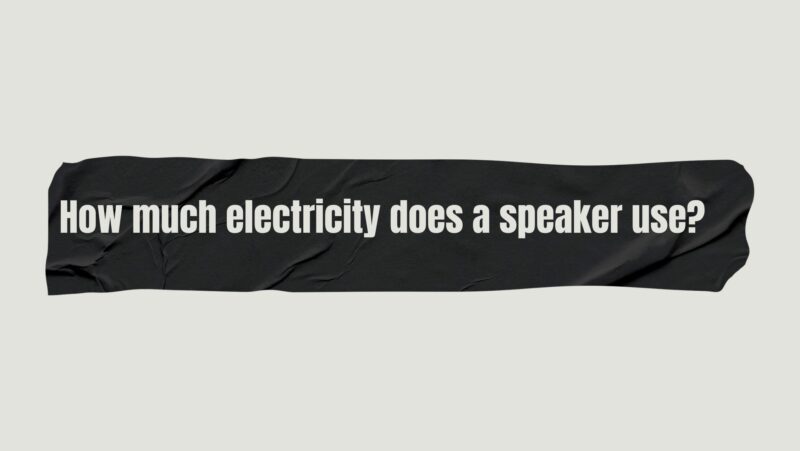In the modern era, where technology is deeply woven into the fabric of daily life, questions about energy consumption are more relevant than ever. Among these inquiries, one that often arises is, “How much electricity does a speaker use?” This seemingly straightforward question delves into the interplay of audio technology, energy efficiency, and environmental impact. In this article, we embark on a journey to demystify the energy appetite of speakers, exploring the factors that influence their electricity consumption.
The Symphony of Sound and Energy
Speakers are the interpreters of sound, transforming electrical signals into audible vibrations that shape our sonic landscape. However, this transformation from electrical energy to sound inevitably involves energy consumption. To gauge how much electricity a speaker uses, we must delve into the intricacies of speaker design, technology, and usage patterns.
The Language of Power Ratings
Understanding the energy consumption of speakers begins with deciphering power ratings. Expressed in watts, a speaker’s power rating offers insights into the amount of electrical energy it can handle and convert into sound. It’s essential to note that a power rating doesn’t directly correlate to energy consumption. Instead, it signifies the speaker’s capacity to handle power and generate sound effectively. In scenarios where higher volume levels are required, such as concerts or outdoor events, speakers with higher power ratings are employed.
Active vs. Passive: Efficiency Dynamics
The classification of speakers into active and passive models contributes to the variance in energy consumption. Passive speakers lack built-in amplifiers and therefore generally consume less electricity compared to their active counterparts, which include integrated amplifiers. Active speakers require power to drive both the amplification and sound reproduction components, potentially leading to higher energy consumption, particularly at higher volume levels.
The Role of Usage Patterns
The inquiry into how much electricity a speaker uses is intrinsically tied to how it’s used. The volume at which a speaker operates, the duration of usage, and the type of content being played all influence energy consumption. For instance, speakers functioning at higher volume levels might require more energy to deliver greater sound intensity. Similarly, playing music with pronounced bass or complex audio might demand more power.
Idle Consumption: Standby Power
The exploration of speaker electricity consumption extends beyond active usage. Many modern speakers incorporate standby functionality, which enables quick activation and remote control convenience. However, even in standby mode, speakers draw a small amount of electricity to remain ready for operation. This phenomenon, often referred to as standby power or phantom power, can accumulate when multiplied across various devices in homes and workplaces.
Quantifying Consumption: A Range of Estimates
Pinpointing an exact figure for how much electricity a speaker uses is complex due to the multitude of variables involved. On average, active speakers can consume around 10 to 50 watts when actively producing sound. Standby power consumption is generally lower, often falling within the range of a few watts. However, these figures can vary widely based on factors such as speaker efficiency, technology, and usage scenarios.
Efficiency Innovations: Minimizing Energy Draw
Advancements in speaker technology are driving energy-efficient designs that aim to strike a balance between audio quality and energy consumption. Some speakers incorporate features like automatic power-off functions after a period of inactivity to reduce standby power usage. Additionally, the integration of energy-efficient amplifier designs and the utilization of digital signal processing (DSP) can optimize power usage without compromising sound quality.
Environmental Considerations
The question of how much electricity a speaker uses intertwines with environmental consciousness. In a world where sustainability is a growing concern, understanding the energy footprint of our devices is paramount. The cumulative impact of energy consumption across numerous devices underscores the need for energy-efficient choices.
Empowering Choices: Making Informed Decisions
Consumers have the agency to influence energy consumption through informed decisions. Opting for energy-efficient speaker models, comprehending standby power implications, and activating power-saving features are steps in the right direction. Additionally, user behavior plays a vital role – simply turning off speakers when not in use and utilizing power strips with on/off switches can contribute to reducing phantom power consumption.
Striking a Harmonious Balance
In the realm of technology and audio, the interplay between electricity consumption and sound quality is intricate. While high-power speakers might deliver immersive sound experiences, they can also result in increased energy usage. This calls for a balanced evaluation of preferences – choosing speakers that align with auditory desires while considering energy efficiency.
Conclusion
In the symphony of modern life, the query of how much electricity a speaker uses resonates as a multi-dimensional chord. As instruments of sound, speakers indeed consume electrical energy, a consumption that is influenced by factors such as power ratings, design, and usage patterns. As technology advances, energy-efficient designs, user awareness, and innovation are collectively contributing to minimizing the ecological footprint of speaker usage.
The pursuit of sonic delight harmonizes with energy consciousness. Through understanding power ratings, selecting energy-efficient models, and embracing responsible usage habits, we bridge the melody of technology with the rhythm of sustainability. By making informed choices, we ensure that the sounds that enrich our lives are not only pleasing to the ear but also considerate of the planet we call home.


